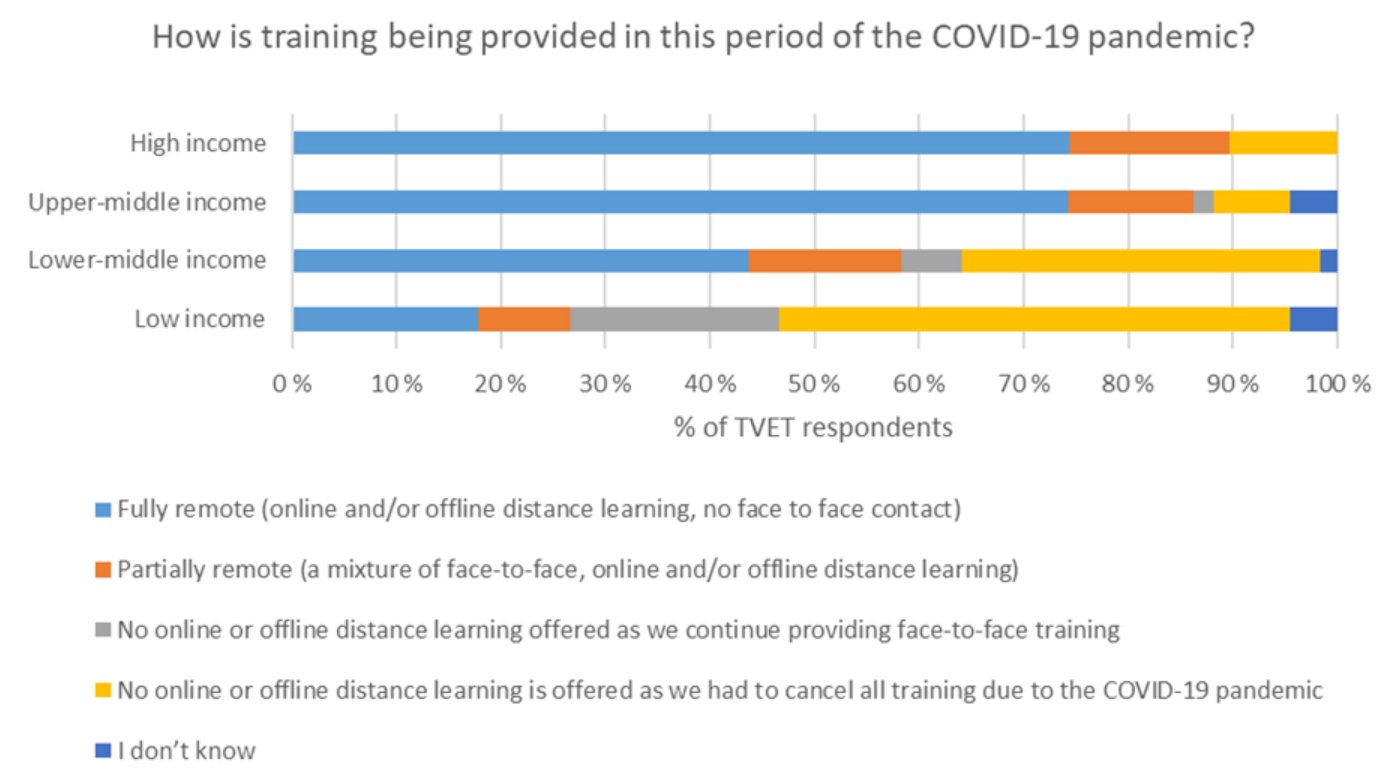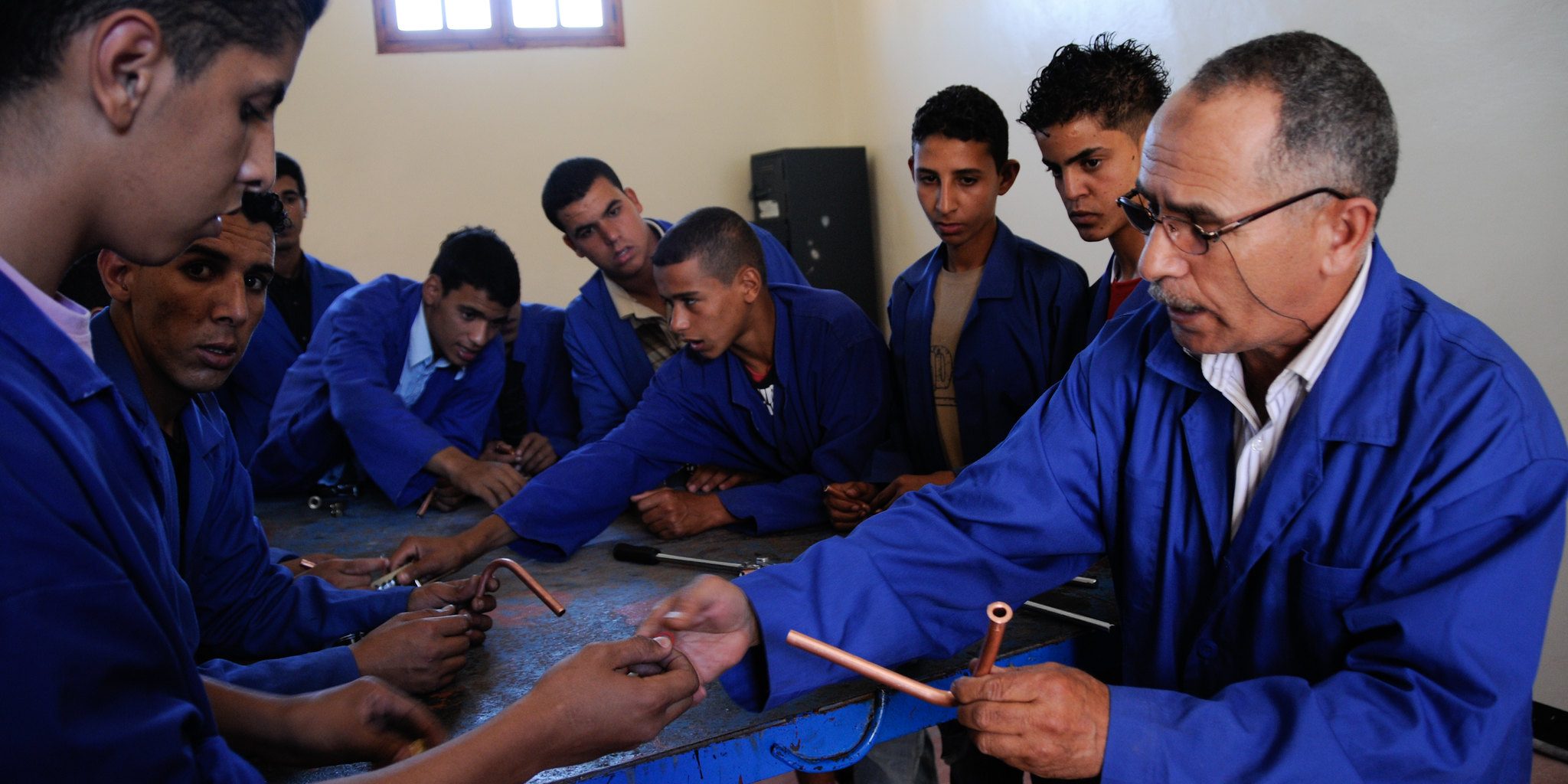Photo credit: Dana Smillie / World Bank
Authors: Margo Hoftijzer, Victoria Levin, and Michael Weber
This blog is also available in French and Spanish.
The scale of the COVID-19 disruption to technical and vocational education and training (TVET) has been truly astounding. Share on X In our May 2020 blog, we predicted that TVET would particularly suffer from school closures as imparting and assessing practical skills is so central for TVET and so hard to do remotely. Now, we have data on the impact of the early stages of the pandemic on TVET delivery. A survey conducted by the ILO, UNESCO, and World Bank in April and May 2020 collected data from over 1,300 respondents in 126 countries, mostly representing TVET providers. The vast majority (90%) of respondents reported complete closure of TVET centers in their country and virtually all respondents (98%) reported disruption of work-based learning. Assessment activities were also halted, with over three-quarters of respondents reporting postponement of certification exams. This is very concerning, as disrupted learning can lead to discouragement and dropout with long-term social and economic consequences. Without remediation measures, this can create a “COVID-19 generation” of workers with lower earnings and lower quality jobs over their lifetime.
COVID-19 outbreak triggered tremendous efforts to promote learning continuity and accelerated the uptake of innovative approaches. Share on X After stopping face-to-face learning, many TVET providers scrambled to transition to remote learning modalities, identifying solutions and partners to facilitate this switch, and establishing support for students and teachers. The responding TVET providers in most countries did not have a pre-existing crisis preparedness strategy, and few engaged in distance learning before. Even so, around two thirds of providers participating in the survey delivered fully remote training by the time of the survey. The pandemic forced even providers that had been slow in exploiting the opportunities offered by technology to quickly adapt, often supported by partnerships between teachers and managers of TVET institutions and schools, telecommunication operators, technology providers, governments, and parents.
Practical training was severely disrupted nearly everywhere, despite some positive exceptions. Most providers were unable to deliver or assess practical skills training, so instead resorted to focusing their remote training on theoretical coursework, hoping to resume practical skills training in the future. Others managed to find ways to focus on practical skills even during peak quarantine. In some instances, apprenticeships continued even when schools were closed. Respondents from Ecuador reported students carrying out practical tasks at home and sending videos and photos of completed work for evaluation by their teachers.
Successful responses were not evenly distributed, and the crisis emphasized pre-existing gaps in accessing learning opportunities. While three out of four TVET provider respondents in high-income and upper-middle-income countries reported providing fully remote training, this was possible only for less than half of TVET providers from lower-middle-income countries and less than one in five in low-income countries. The dominance of high-tech solutions, such as video conferences and virtual learning environments, could also have exacerbated digital divides within countries. Evidence from a remote learning program in India suggests that students from lower-income households had limited access and difficulties engaging with remote learning sessions due to internet charges, device quality and electricity outages. This demonstrates the value of multi-channel (or multi-modal) delivery approaches in supporting continued access to learning for all, as was done for TVET in Afghanistan during the COVID-19 crisis.

Source: ILO-UNESCO-World Bank Online Survey, 2020
2020 was a year of intensive creativity. For example, as discussed in a recent webinar, the government of Mongolia in 2020 experimented with training interns on-site; created a digital curriculum database; and developed a digital monitoring and information system. It is now concentrating on improving the digital skills of learners and teaching staff and contemplates shifting to more flexible short courses to better respond to employers’ needs. In Brazil, the network for industrial training (SENAI) significantly expanded its virtual offer and capacity in 2020. In addition to expanding virtual learning options for its students, it created a platform to support SENAI pedagogic staff in developing and delivering content remotely, and a digital innovation hub where firms can articulate real-world challenges to be addressed by SENAI students.
TVET systems need to address short-term implications of the pandemic and persistent structural problems. Share on XResponding to the pandemic involves preventing and remediating dropout and reversing learning losses as well as reskilling workers to strengthen their employability in a labor market that may have structurally changed. At the same time, many TVET systems worldwide still need to address important structural gaps that persistently weakened their performance even before the pandemic.
The pandemic exposed weaknesses in TVET institutions and systems, but the scale of innovation and experimentation also showed that rapid change is possible. Share on X As economies, schools and training centers reopen, there is an urgent need for skills development mechanisms that are tailored both to students’ individual needs and to the changing skill needs on the labor market, with digital skills, socioemotional skills, higher-order cognitive skills, and adaptability being valued more than ever. This opens a window of opportunity as stakeholders realize the potential and need for structural reforms of TVET for better skills development and better jobs.
A new joint initiative by the World Bank, ILO and UNESCO will support these efforts by providing lessons learned and good practices on key aspects of TVET provision. This work aims to support systemic reforms to improve the performance of TVET in low- and middle countries on the key dimensions of access, equity, quality, and relevance. Share on X It will generate new knowledge on five focus areas: technology; teachers; demand-responsiveness; work-based learning; and assessment and certification. These five areas were indicated as the hot topics with the largest knowledge gaps for TVET around the globe based on consultations with stakeholders worldwide. We expect first results of this work later this calendar year and will report on them here. Stay tuned!
This blog was first published on the Education for Global Development blog platform.




